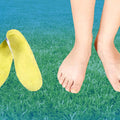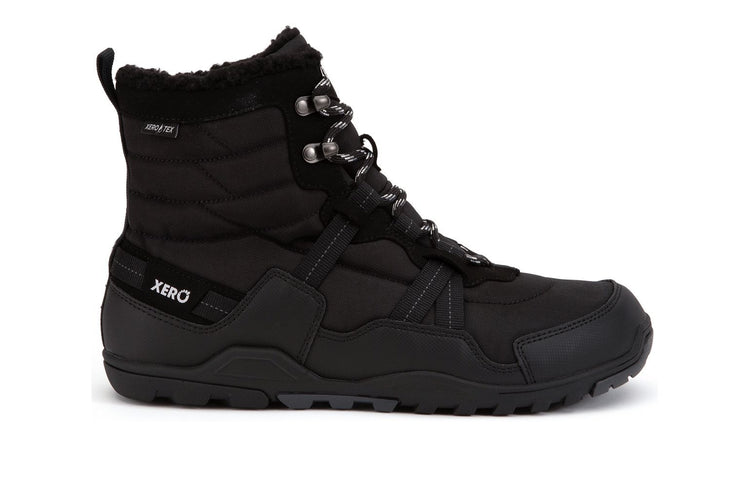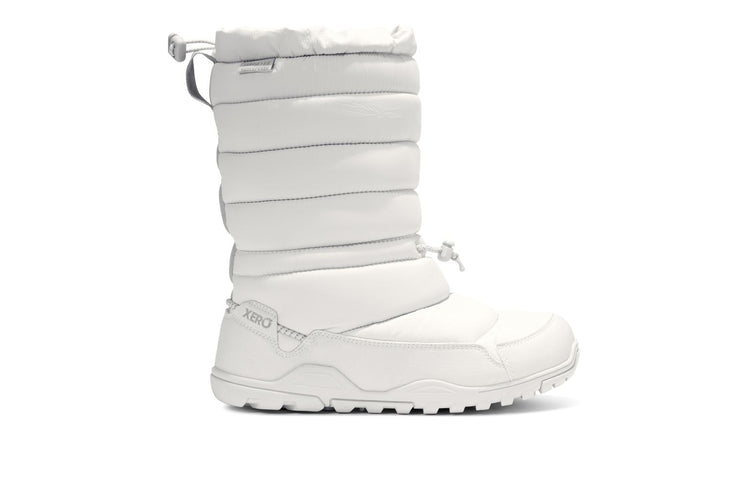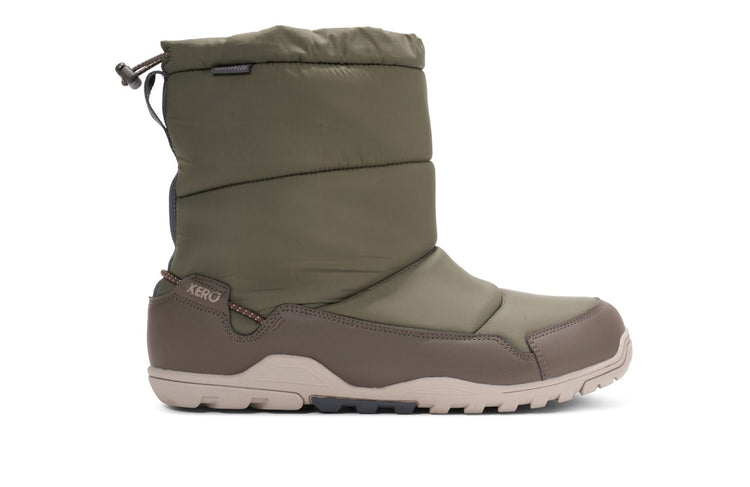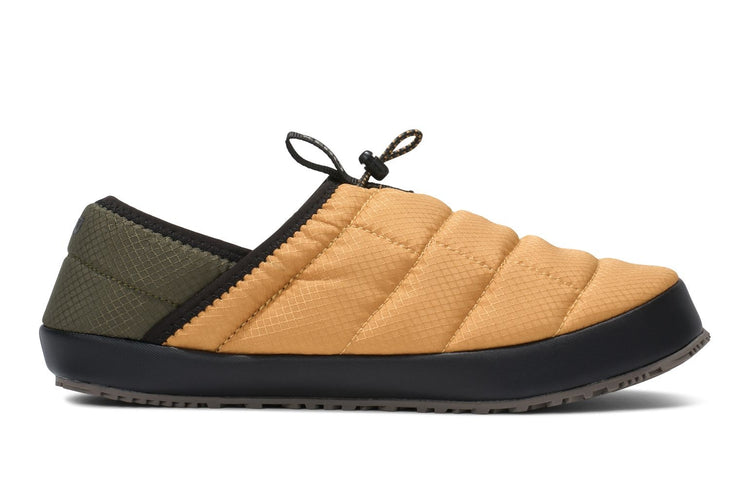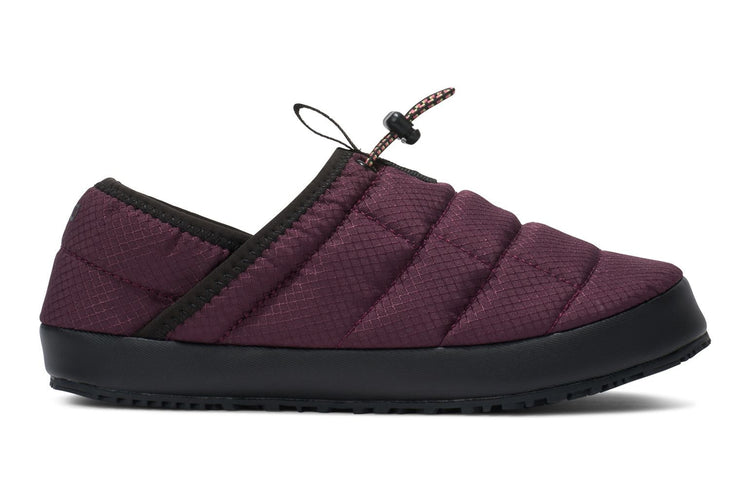latest News
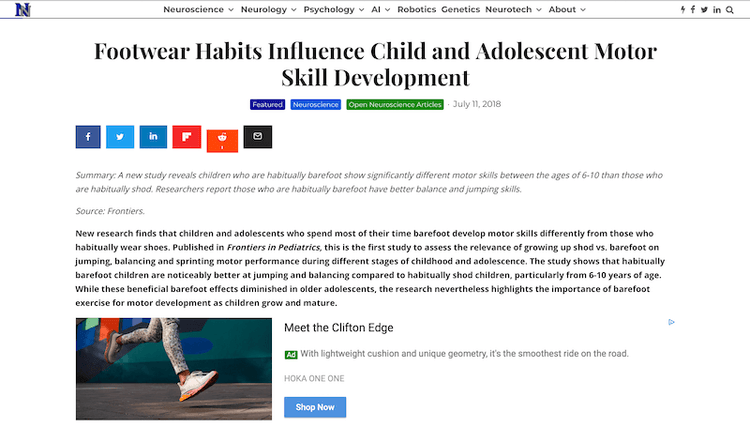
Is Barefoot Best for Kids? Research says...
This just in to the "I'm not surprised" department:A new study reveals children who are habitually barefoot show significantly different motor skills between the ages of 6-10 than those who are habitually shod. Researchers report those who are habitually barefoot have better balance and jumping skills.You can read the article here.I'm curious to hear what you see when you go to the article. Because, in the great irony that Internet advertising sometimes delivers, what I see when I go to an article recommending that kids be barefoot is an ad for one of the least barefoot shoe you can buy:HYSTERICAL.Now I know some people will read this and say, "But Steven, you sell kids shoes!"It's true. We do.But keep in mind these few things: We always say that "barefoot is best"... when appropriate (sometimes it's not, for various reasons) Most people will never spend the majority of their time fully barefoot We make our shoes, boots and sandals to give you the closest thing to a barefoot experience that you can have, given the constraints about "appropriate." For example, for those who aren't yet skilled enough and adapted enough to hike barefoot, we make trail shoes that are still lightweight, flexible, have wide toe boxes, and give you as much ground feel as possible while still giving you the protection and traction you currently need Give the above, we like to remind ourselves of something Harvard's Dr. Irene Davis has said that if kids grow up in footwear that lets their feet move and feel naturally, in 20 years we won't have adults who are being treated for the issues today's adults have. If your kids are spending more time barefoot or in minimalist footwear, what have you noticed about them compared to kids in constricting, padded, motion-controlled shoes (like that one in the ad I saw)?Let us know in the comments, below...
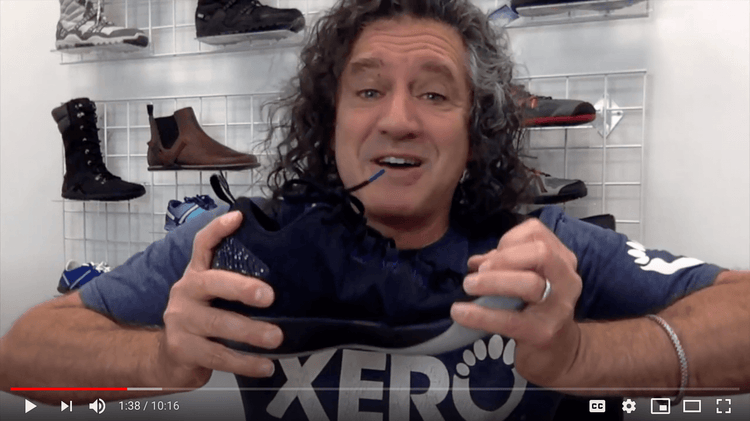
How to find TRULY comfortable shoes
The secret to finding comfortable shoes...It's probably not what you think.And it's definitely not what "Big Shoe" companies have been saying for the last 50 years.It's not because you need more arch support or better cushioning or to control your pronation or supination.The secret is actually what humans have been doing for ages.The secret to TRUE comfort is letting your feet do what's NATURAL.Think about this -- did you know 1/4 of the bones and joints of your ENTIRE body are in your feet and ankles?Did you know you have more nerve endings in your soles than anywhere but your fingertips or lips?CLEARLY, you're supposed to USE those things at the end of your legs.Your feet are made to bend and flex and move and FEEL the world (you'll want to do that safely, and I'll show you how).And it gets worse >> When your feet can't do their job, that function of helping you move and balance tries - UNSUCCESSFULLY -- to move "upstream" into your ankle, your knee, your hip, and your back.You want to let your feet do their job, so the rest of your body can do its job.But most shoes do the opposite of what's natural -- they squeeze your toes together, they elevate your heel (which messes with your posture), they insulate you from the ground so your brain can't tell what's going on with your feet (which means it doesn't have the info it needs to help you move your body efficiently and enjoyably).And NO amount of cushioning protects you from the impact of walking or running, or even just standing.ANOTHER QUESTION -- Remember being a kid on a warm summer day and going outside, kicking off your shoes, and feeling the grass between your toes, or the sand under your feet, or the water around your ankles?Remember how much fun it was to PLAY... until it got so dark your parents had to drag you home, even though you couldn't see your hand in front of your face or the ball you were trying to kick or hit?You can have that feeling of fun and freedom NOW... at any age.It comes from letting your feet do what's natural.Now, I'm NOT suggesting you run around barefoot like some aging hippy (I know that's what I look like, but my wife said she'd leave me if I cut my hair!)Once my wife and I discovered the fun and the benefits of natural movement, we started Xero Shoes to make footwear that LETS YOUR FEET BE FEET: - Natural Fit -- wide toe boxes let your toes spread and relax. A non-elevated (zero-drop) heel for proper posture. - Natural Motion -- super flexible to let your feet bend and move naturally. Low-to-the-ground for balance and agility. - Natural Feel -- the patented FeelTrue® soles give you just-right protection while still giving the ground feedback your brain needs for efficient, natural movement. All our casual and performance shoes, boots and sandals are super lightweight. They're made for almost any activity you do -- walk, run, hike, workout, do yoga or CrossFit, or even just stand on your feet all day for work.They're so comfortable that at the end of the day you may forget to take them off!We've had people email us to say, "I got into bed and then realized I was still wearing my Xero Shoes!"Plus they're affordable and so durable that they have a 5,000 mile sole warranty.Oh, and yes, we WERE on Shark Tank ;-)We've helped hundreds of thousands of people discover the fun, comfort, and benefits of natural movement and we hope you decide to do the same.Go to https://xeroshoes.com/shop/ to see which styles have your name on them. Check out the reviews (over 17,353 5-star reviews!), and get ready to Live Life Feet First!(And if you have any questions, our Customer Happiness Team is available to help -- 303.447.3100 or support@xeroshoes.com)
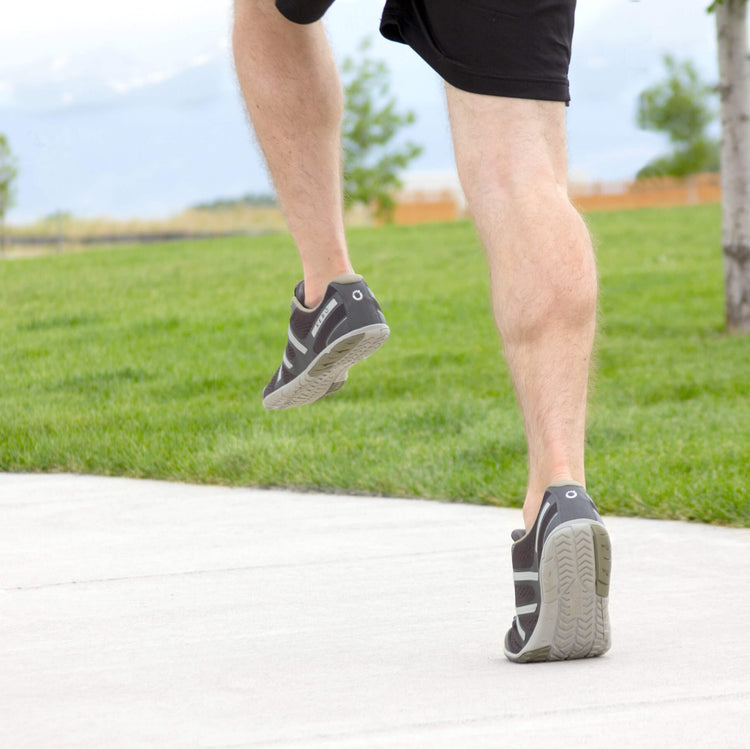
How to Avoid Injuries with Minimalist Shoes - Xero Shoes
How To Avoid Injuries When Transitioning To Minimalist Shoesby Danny Dreyer, Founder of ChiRunning/ChiWalking, www.chirunning.comUpdated: July 22, 2022The minimalist running shoe boom, a trend that the pain-free ChiRunning technique welcomes, has led to a discussion about the issue of running injuries. There have been reports of new types or increased rates of injuries resulting from running in minimalist running shoes. This is ironic, since the reason many people have been inspired to try minimalist shoes is to prevent or alleviate injuries.I’m a fan of minimalist running shoes. But they aren’t magic. The idea that switching to minimalist shoes will, all by itself, keep you from injury is wishful thinking. They can indeed help you learn to run in a way that is easier on your body. But it is important to understand how minimalist shoes help — and how you can cooperate in the process.So I’m going to first explain why switching to minimalist shoes might lead to injuries in some people. Then I’ll explain how minimalist shoes can actually make you a better runner who is less likely to experience injuries.“Better” Shoes Lead to Bad HabitsIn order to understand why minimalist shoes can lead to problems, we first need to talk about the more common running shoes people are used to. Why? Because when you get used to running in certain kinds of shoes, you actually get used to running with a certain form. Form is where all the action is, as I will explain a bit later.But first, let me tell you about “traditional” running shoes. As “power running” became widespread in the ‘80s and ‘90s, running shoes grew clunkier and thicker. Shoe companies taught us that more cushioning equaled better protection from ground reaction forces for a lowered injury risk.You can see the logic here. It seems obvious to everyone that running involves a lot of impact with the ground and that impact is connected to various kinds of running-related injuries. Cushioning should help to reduce impact, which in theory should lead to fewer injuries connected with it. So conventional shoes have continuously added more of it.That’s the theory. In reality, the excess padding in conventional shoes doesn’t actually reduce impact forces and it inhibits our ability to feel the impact of our foot strikes and the subsequent damage we may be doing to our bones, joints, and muscles with each step. It is easy to end up with a form that generates a lot of impact force but we just don’t notice it because of the cushioning.Research has provided evidence to support this. A study by Dr. Daniel Lieberman found that the cushioned, elevated heel of “traditional” running shoes encourages runners to use a rear-foot strike with greater collision forces compared to the mid- or fore-foot strike and smaller collision forces of barefoot runners.And what about injury risk with those heavily-padded running shoes? We can at least say this much. Injury rates for runners do not seem to have decreased over the years, even as padding has become more pronounced. Somewhere between 30-70% of runners are injured each year.The really important thing to notice here is this: there are different ways to run and different foot strike patterns. Conventional shoes seem to encourage running with a form where the heel strikes first.How Can Minimalist Shoes Lead to Injuries?Many people have become interested in minimalist shoes because they have heard that they are more natural and better for you. Always in search of the magic bullet, people tend to go to extremes when they hear of something promising. It happens with diets, with politics, and in this case, with running shoes.When you take a runner who is used to running in thick-soled conventional running shoes and landing on the heel and put him or her in a pair of minimalist shoes with very little padding, you can easily see the potential for problems. If that runner continues to heel strike, with their foot landing in front of their body, the impact forces that used to be somewhat blunted by the thick padding are now sent jarringly through the bones of the foot, ankle, and knee. That will take a toll on the body.One of the things that helped inspire the barefoot running movement and a greater interest in minimalist footwear was the book Born to Run. In it, author Christopher McDougall told the story of how he loved running but had been plagued by injuries. He happened to hear about a tribe in Mexico famed for both long-distance running and general well-being and decided to investigate.He found, to his surprise, that they ran in thin, basic sandals without any support (called huaraches). The key conclusion he draws in the book, however, is this: it wasn’t so much the fact that they ran in sandals that kept them injury free. Rather, it was the form that the sandals encouraged them to adopt that was the key.In brief, McDougall argues that form is the key factor and form follows footwear.So simply changing the type of running shoes you are wearing isn’t going to help you all by itself. Indeed, it can even make things worse.Here’s How Minimalist Shoes May Help Prevent Injuries ChiRunning has advocated for minimal shoes since 1999, but always with the caveat of one of the pain-free ChiRunning technique’s main tenets: Gradual Progress.Putting on a pair of minimal shoes does not automatically change years of movement patterns you have established. The truth is running in minimal shoes or barefoot shoes will give you form feedback that overbuilt shoes won’t. The key to preventing injury lies in responding to this feedback by making adjustments to your technique.In other words, minimalist shoes allow you to actually feel what is going on in your body. When you don’t have a lot of padding to cover it up, crashing your heel into the ground hurts. Paying careful attention to what you’re feeling and being willing to adjust your form accordingly is the key to adopting a form that will be gentle on your body and minimize your chances of injury.Practical Tips for Getting Started with Minimalist Shoes without Injury RiskFor a healthy transition, follow these tips to avoid overuse injuries that can plague minimalist or barefoot runners: Take it slowly and don’t expect to be running your current mileage as you switch from your current shoes to barefoot running or minimalist shoes. If you’re transitioning to barefoot running, do it on a hard surface or a track and not on grass (contrary to popular opinion). Because grass offers such a soft surface, it can be difficult to tell if you’re heel striking. Running on a hard surface will give you immediate form feedback and “force” you to land softly or suffer the pain. If you go cold turkey and toss your old shoes in exchange for minimalist or barefoot running, start by running very short distance intervals, such as 200m or less, just to see how it feels. Then, walk for the same distance. This helps toughen your feet without creating as much impact as running. Switch back and forth between walking and running as your body allows. The 10% increase rule applies here – start with very short runs and add no more than 10% of an increase in mileage (or time on your feet) in one week. Be very cautious if you’re switching to minimalist or barefoot running if your BMI is 25 or higher, as the increase of impact to unprotected feet magnifies significantly if you’re overweight. If your BMI is 30+, you might consider losing some weight before switching to the minimalist approach. Try walking in minimalist shoes first and increase your mileage slowly. For at least the first month, do most, if not all, minimalist or barefoot runs on level ground, not on hills. Running uphill places increased stress on your Achilles’ tendons, while running downhill places more impact and stress on your plantar fascia, the soft tissues of the bottoms of your feet, as well as your calves and your shins. Make sure you are running with biomechanically correct running form on the first day of your switch to minimalist or barefoot running. Shorten your stride Don’t heel strike – land midfoot Keep your knees bent Relax your lower legs throughout your stride cycle Maintain good posture with a slight forward lean from the ankles When approached mindfully, there is no reason why anyone should suffer injury from switching to barefoot or minimalist running. Without the extra bulk and padding, your body will truly sense what the ground feels like and respond accordingly. Educate your feet gradually, and allow your body to adapt at its own pace.Ready to make the transition? Find the perfect pair of Xero Shoes for your journey.The content of this post does not constitute and is not intended to be a substitute for professional medical advice, diagnosis or treatment. Always seek the advice of a physician or other qualified health provider with any questions or concerns you may have about your health or a medical condition.Answers to a Couple Common QuestionsAre minimalist shoes the same thing as barefoot shoes?They can be, but manufacturers are not always consistent in the way they use these terms to describe their running shoes. In the most basic sense, minimalist shoes are supposed to be just what they sound like: as little shoe as possible to do what a shoe’s primary function is — to protect your foot.True barefoot shoes will have three key features. They’ll be zero-drop, meaning there is no elevated heal but they have the same level of padding from heel to toe. They will have minimal padding to allow your foot to feel and interact with the ground naturally. They’ll have a wide toe box to give your feet the room they need to move. Sometimes minimalist shoes have all these features, sometimes they don’t. So do your homework and make sure the “minimalist” shoes (or barefoot shoes) you are buying give you the true minimalist experience.At Xero Shoes, all our footwear has the features just listed and is also super lightweight. We have a broad line of products for different uses. Find your shoe here.Is running barefoot the same as running in minimalist running shoes?This question is similar to the question above. Running barefoot often means just what it sounds like — running without any shoes on at all. There are various reasons people want to try barefoot running, including injury prevention due to an improved running form, as discussed above.It isn’t always possible or even desirable to run with literally nothing on your feet. Fortunately, minimalist running shoes are designed to mimic being barefoot as closely as possible while still giving your feet some protection from the environment. That means shod runners can also enjoy the benefits of true barefoot running.Where can I find those “Knees over toes guy” shoes?Those shoes he’s wearing: They’re Xero shoes. Find your perfect pair here.We’re thrilled Ben Patrick, founder of ATG Coaching, discovered us and has inspired many others to switch to Xero Shoes, too. We’re glad you’re here and hope you found this article useful.Where can I find out more about running barefoot or in minimalist shoes?This article talks a lot about traditional running shoes compared with minimalist running shoes. If this area is new to you, you might have lots more questions about barefoot running (or barefoot-style running). As you probably guessed from the article, even experienced runners making the switch to barefoot running (or running wearing a minimalist shoe) have plenty to learn.You’ll find lots of resources in our blog under the category barefoot running. Here’s the link.
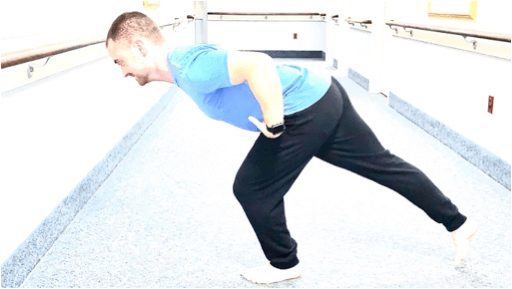
How to Perfect Your Balance
Have you always thought that you just aren't someone with good balance and that's that? Think again. It is totally possible to improve your balance! So how do you do it? Just like a weightlifter needs to lift progressively heavier weights to get stronger, if you want to improve your balance, you need to challenge your balance by placing yourself in unstable positions. In doing so, your body will develop the reflexes needed to maintain balance in that unstable state. This means that you need to be doing exercises that make you wobble...for if you are not wobbling, you are not being challenged. In time, a given activity that once made you wobble, will soon become easy and so you will need to move on to a more difficult activity.Safety first: If you’re concerned that you might fall during a balance exercise, always keep your hand close to some type of support like a sink, counter, or sturdy chair. However, when performing the exercises, you should keep your hands just above your security support and only use them when you feel like you may fall. By having your hands just above the support, you will not rely on your hands to steady yourself and instead will use the balance reflexes found in your feet, legs, and torso. So, let's begin. For an extensive list of balance exercises I regularly use as a physical therapist for patients, head to https://programs.perfectingmovement.net/catalogIf those exercises are either too easy or too difficult for you, all balance exercises can be made more difficult by reducing the amount of visual input you are receiving. This can be done by performing the activity in a darkened room, with eyes squinted, or with eyes closed. In this way, it will limit the amount of visual input your brain receives and so will force you to rely more on your other systems for sensory input.Exercises can also be progressed/modified by standing on an unstable surface such as a foam pad, BOSU ball, wobble board or even a slack line, all of which of course will make you wobble more. As always, anytime you are wobbling, you are challenging yourself and are actively in the process of making your balance better!In this program, I have balance exercises for people of all ages ranging from high-level athletes to geriatrics.So, are balance exercises for athletes too??Absah-freakin-lutely...having good balance as an athlete is crucial toward preventing injuries. This is because good balance is essentially having good neuromuscular control. Without good neuromuscular control, one loses control during movement, and so is at a much higher risk of getting injured. Think about it: Running, cutting, sprinting, braking: all of this happens on one leg at a time. Therefore it is essential to have good neuromuscular control on one leg; ie good balance. Squats and deadlifts are great exercises, but they won’t improve your control/balance on one leg needed for activities like sprinting, cutting, running, and pivoting. Therefore, awesome single balance = not getting hurt = being a real winner.Footwear which can immediately create better balance:When using a thinner, flatter shoe with a wide toe box, one typically has better balance. This type of footwear is called “minimalist”, or “barefoot” footwear. Xero Shoes are definitely my preferred minimalist shoe brand.Here are some of the characteristics and benefits of a minimalist footwear: A wide toe box which allows the toes to splay, creating a wider base of support. A flat sole without support which does not throw off the natural positioning of the foot and ankle. A thin sole which places one’s center of gravity lower to the ground to create improved stability. A thin sole which also allows one to feel the ground more easily. In this way the brain has faster and more descript sensory input needed to create more rapid and effective balance reflexes. In contrast, most traditional shoes have thicker soles, motion limiting “support”, narrow toe boxes, and elevated heels. All of this will disrupt the body’s natural sensory and reactive needed to maintain balance.As a physical therapist, I have had AMAZING success in getting my patients in a minimalist footwear for both reducing pain and improving balance. Once my patients start using minimalist footwear, it is extremely common that they report feeling more balanced and more confident on their feet.Lastly, it is essential that one learns how to walk with proper technique in order to prevent a loss of balance, slip, or a rolling of the ankle. This is because walking with good technique places the foot more beneath the center of mass so that you have better control. Often people take an excessively long stride where the foot is too far forward from the center of mass. The further the foot is away, the less control you have and so are at higher risk of injury. As a guy who used to constantly sprain his ankle, I no longer do so. What changed? I almost exclusively use minimalist shoes and have improved my walking and running techniques. Here is a great video resource to learn how to walk the right way from PerfectingMovement.Net.– James O’Brien MSPT, OCS, CSCS, from PerfectingMovement.netThe content of this post does not constitute and is not intended to be a substitute for professional medical advice, diagnosis or treatment. Always seek the advice of a physician or other qualified health provider with any questions or concerns you may have about your health or a medical condition.
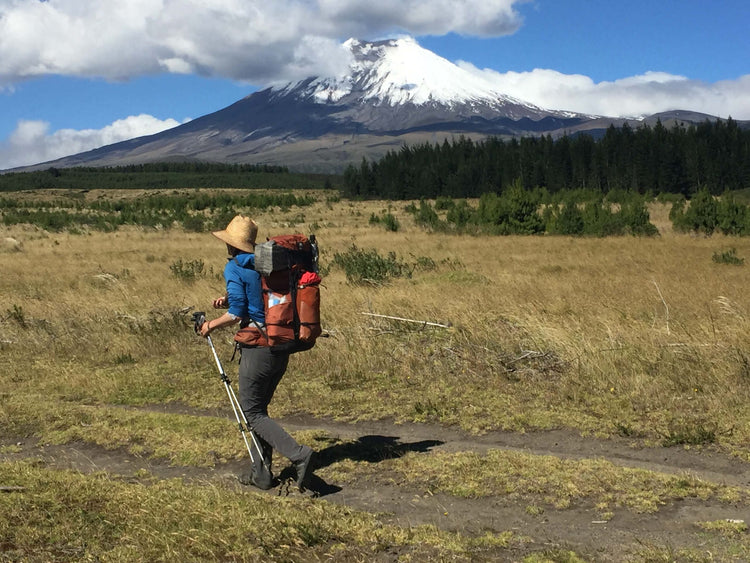
Foot Care for Endurance Athletes
“And forget not that the earth delights to feel your bare feet.” Khalil GibranOf the 206 bones in your body, 52 are in your feet. Each and every one contributes to getting you to where you are going and is a potential major hindrance if not cared for. As a long distance, long term athlete, I spend a lot of time on my feet. Over the last 7 years I have hiked 12,000 miles, paddled 1,500 miles, and bikepacked 4,000 miles. With 3,500 miles left to complete a non-motorized traverse of the Americas, physical maintenance, and specifically foot care, is crucial.One of the important lessons I’ve learned has been moderation. It sounds silly putting those two thoughts into the same sentence but it is a fundamental truth to how I’ve been able to keep going for so long. Maintaining a pace and stride which works for me, resting when my body needs it, and giving it the resources it needs to stay healthy and moving are all examples of moderation and care which I began learning when I started thru-hiking over a decade ago. And which I continue to learn and relearn when my body makes her demands known or insists in the form of months of illness, repeated bouts of overuse injuries, or other physical break down.Interestingly, these sorts of issues don’t usually spring upon you all at once. There are signs, symptoms. That tweak in your lower back. Is that a one time thing or is that the beginnings of chronic pain? Every endurance athlete knows this fear and the fact is, you never can know which it is going to be. What you can do is incorporate a steady practice of care and strength building to give your body its best chance. Similarly, there are dozens of small things you can do to prevent going down that road, or to aid in recovery as you regain strength and stamina. These are a few of those small practices which can make a big differenceDry Your FeetI spent the first 3 years of my backpacking career battling with trench foot. I came to think it was simply part of the experience. I tried doubling up on socks, traded my way up into Gortex boots and the issue only worsened. When wearing shoes and socks, your feet are experiencing a very different climate than the rest of your body. Usually it is a warm, damp environment, just the sort of place fungus like to grow. I was super glueing deep cracks in my heel shut. Until finally one day I swung in the opposite direction and wore lighter shoes and began airing my feet out more often. I quit sleeping in socks and the issue subsided.If you go barefoot or wear open sandals, your feet will be able to dry naturally. Still, if you are on a multi-day trip, rinse or wipe your feet off at the end of the day, paying special attention to the areas between your toes. Not only will this keep your quilt or sleeping bag cleaner, but it will also keep your foot skin healthier.When you are in a closed shoes sort of environment giving your feet time to air out whenever possible. Whether that is under your desk at work, on a lunch break along the trail, or the drive home from the trailhead, keeping your feet clean and exposed to the open air contributes significantly to your foot health. Mix it UpCross-training caught on in the endurance sport world over the past 20 years. All our muscle groups were made to work together so having one set particularly overdeveloped while others languish, doesn’t serve the sustained health of our physical systems in the long run. The same goes for our feet.While thru-hiking the CDT this past summer, I was retraining my feet after several months spent exclusively in my Xero sandals on sandy beaches and in a kayak. Due to constant high mile days, the weight on my back, and the terrain, I opted to hike in trail runners with more padding and zero drop and quickly began to have arch pain. Thus I began alternating between my sandals and trail runners throughout the day.Once the frosty mornings were past and when I took a breakfast break and aired out my feet, I would switch into my sandals for a few hours until lunch. At big river crossings, on smooth trail, and around camp, I was in my sandals. On thorny bushwhacks, across lava rock, and other rough environments, or at the end of the day when I was tired and not able to be as careful with my step, I would switch back into my trail runners. This switching back and forth made me very aware of my gait which is helpful because a hyper-extended gait is a leading cause of shin splints. While the cushion of the trail runners invited this sort of step, my Xeros reminded me not to fall into that.Thus, if like me, you aren’t ready to spend 100% of your time barefoot, there are still many ways and a lot of space for barefoot practices to improve your awareness of how you move, and your experience of both your body and the outdoors. Thank Your FeetNow, here I may get a bit hoakey for some folks, and I don’t mind if you skip on to the end, but at the end of a long and challenging day, I like to thank my feet. I leave my shoes at the vestibule, peel off my socks, and either soak my feet in a nearby stream or give them a good wipe down with a baby wipe. Then, sitting in the butterfly position or lying on my back in a modified happy baby pose, I wrap my hands around my feet and begin to stretch. Beginning just above my ankle bone I rub small circles and check in with all those tiny bones. With the texture of my skin. With the cracks in my skin. I thank them for the miles they have put in. Marvel at the ground they have covered and conditions they have weathered. Doing this I work my way all the way down the tops of my feet and then begin again at the ankles and cup my heel. In thru-hiking, that part of the foot takes a lot of heavy strikes and a lot of modern footwear encourages this, so they get an extra thank you for taking that extra whooping. Focusing on the soles of my feet and paying particular attention to both arches, I make my way to the toes. Stretching each toe individually and then tugging outward from the tip, pulling them long and a good final stretch before crawling into my sleeping bag and asking my body to do it all over again tomorrow.Endurance athletes ask a lot of our bodies but every thru-hike, ultra, or even just a junt around the block starts with one small step. The same measured moderation and care applies to foot care. Taking a few minutes out of your day or tacking a few extra on to your training routine may be hard to convince yourself of when you are trying to make miles or balance a busy lifestyle. Whether it is washing and airing out your feet, switching out shoes, or staying awake a few minutes longer in your tent to stretch your soles, small steps can make the biggest difference in the long run. After all, your feet are carrying the most weight on your body, giving them a few minutes of dedicated care is the least you can do.–Adventurer Bethany Hughes The content of this post does not constitute and is not intended to be a substitute for professional medical advice, diagnosis or treatment. Always seek the advice of a physician or other qualified health provider with any questions or concerns you may have about your health or a medical condition.

Can you get Energy Return from your shoe's cushioning?
I wish more people understood physics better.Sure, I say this in part because I got interested in physics at an early age. When I was 14, I was tutoring people 3-5x my age in antenna design, electronics, and other physics-related topics (I was an Extra class ham radio operator).But the other reason is that knowing physics makes you immune to certain types of marketing spin, which can save you countless hours of time (not having to personally test something that's patently false), and money (not buying products marketed with misleading bastardizations of principles of physics).It also makes you an unpopular party guest, since people don't like having their mythology bubbles burst, and when you overhear someone spouting incorrect explanations of reality, it's impossible to walk away without tossing in a corrective comment.At least I can't.What does that mean when it comes to finding comfortable shoes, sneakers, sandals, and any other type of footwear?Two words:ENERGY RETURN FROM RUNNING SHOES? Running shoe companies in particular tout the "energy return" of their foam or other types of cushioning.The more energy return, the better.Makes sense, right?Well, let's just say that if I heard you waxing eloquently about the energy return in your new, super expensive, high-tech, cushioned shoes while you sip a beverage from a Solo cup, I'd force my way into the conversation and say:"There is no such thing as 'energy return.' "Even if I didn't have my own Solo cup's worth of liquid (and it would probably be water; I'm not much of a drinker), I'd then blurt out:"There are only different levels of ENERGY SUCK."It's just physics.No foam or cushioning or springs or shock absorbers or carbon plates or anything else that's ever been added to any part of a shoe has ever RETURNED more energy than you put into it when you land on it.Therefore, all of those components SUCK energy from you.Think about a trampoline. Sure you can bounce really high... but only until your leg muscles get tired. The trampoline bed optimizes the combination of gravity and your musculature (but only to a point, since you don't keep bouncing higher and higher forever).Same thing with foam in your shoes.The foam sucks.And, worse, it sucks more and more with time because it begins to break down the moment you start using it.My friend, Dr. Geoffrey Grey from Heeluxe (a footwear research firm) just wrote a great post about this: Why Energy Return is a MythHe addresses the new Nike Vaporfly 4% and the Nike Next % as well as the VKTRY insoles, but his points apply to all shoes Here are the highlights: Key Point 1: All foams lose energy.We already touched on this. And, again, it's not just foam.All cushioning does the same thing. Key Point 2: Carbon Fiber isn’t typically used as an energy return material.The carbon fiber in the Nike shoes and the VKTRY insoles is held out as part of the energy return equation.Carbon fiber is stiff.If you think about it, having a layer of carbon fiber is just adding a non-compliant surface into the shoe... like a road or a track or a sidewalk.There are some who claim that the carbon fiber plate in the Nike shoes "act as a lever" and that's what creates energy return.Again, sounds good unless you understand physics.For a lever to function, it needs a fulcrum.There's nowhere in the shoe that's a point on which the carbon plate rests or pivots.Even more, check out where the runners in Eliud Kipchoge's sub-2 hour marathon land on their foot (and therefore in the shoe):Notice where they're landing?Midfoot and forefoot.There's no fulcrum under the midfoot. So, no lever. Just something solid, again, like the ground.Next... Key Point 3: Shoes with higher energy return on mechanical “ball drop” tests won’t work for everyone.The "ball drop test" is how most shoe companies demonstrate their "energy return."They literally drop something like a 2 pound metal ball onto the sole of the shoe, or the cushioning material, and see how far it bounces back toward the original height.Physics -- NEVER higher than where it started.Reality -- YOU ARE NOT A SOLID 2 POUND METAL BALL! (I'm assuming)The ball is only accelerating toward the sole based on gravity (accelerating a 9.8 m/s squared). You are not falling from that same height and the force that you hit the ground is not the same as a 2 pound steel ball.If you weigh 150 pounds, you could hit the ground with 500-600 pounds of force, or more! And your muscles, ligaments and tendons allow your joints to BEND, unlike the metal ball which doesn't compress (okay, technically it does by a TINY amount).More Physics -- foam breaks down from the moment you start using it, so the ball test results will change over time.In fact, the reason most shoe companies tell you to replace their shoes every 3-500 miles is that this is when they think the foam has degraded to the point of being useless (and, often, they make sure the rubber outsole wears out at about the same time).SHOE SECRET -- most foam is barely better at 300 miles than 500... and often it's just as bad at 200 miles! Key Point 4: Foams with higher energy return feel good to some people.Feeling good is a wonderful thing.But that doesn't mean it's DOING something good for you.Let me ask you a question:If you were going to do pushups, would you rather do them on the floor or on a memory foam mattress?I'm guessing you said "Floor" and the reason is that you know a foam mattress is squishy and would make you unbalanced, while the floor gives you something solid and stable as a base.This is basic Newtonian Physics (the 3rd law) -- For every action, there is an equal and opposite reaction.If the opposite reaction is squishy, it messes up your initial action.The mattress FEELS good, but isn't good for natural movement.Same thing with foam in a shoe.Wrapping it up...Needless to say, we think of Xero Shoes as "physics friendly."Our barefoot shoes don't use unnecessary amounts of foam. We don't use marketing spin to take something bad (foam sucks energy) and re-label it with something that sounds positive, like "energy return."We believe that you're smarter than that.Even if you don't know a lot about physics ;-) What do you think? Leave a comment, below.
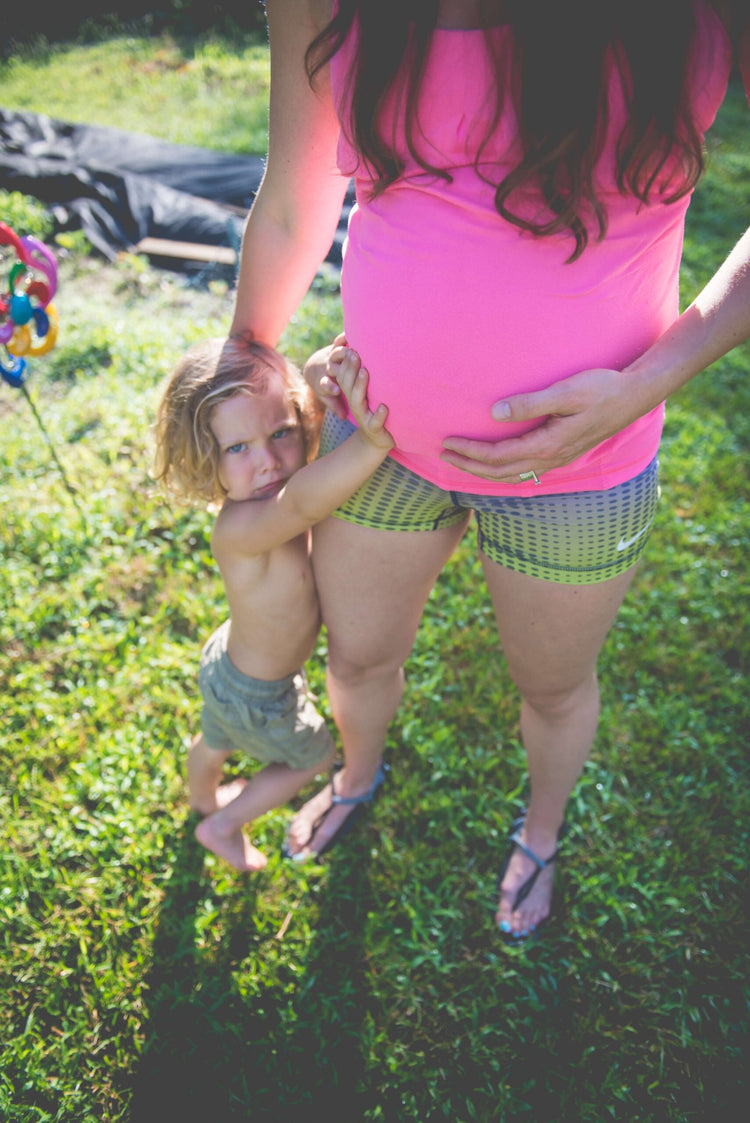
Why it Makes Sense to Switch Your Shoes During Pregnancy
From a big picture standpoint, pregnancy is a time of growth and change. The anatomy of a mother’s body is rapidly adapting to the projected growth of the fetus (things like a widening pelvis and ribcage, changes in spinal curvatures, stretching of abdominal tissues, and shifts in the center of gravity). A lot of the changes happening are credited to relaxin, a hormone that is found in numerous tissues and systems throughout the body, but increases during pregnancy and breastfeeding and acts to relax tissues.One of the changes that many women experience during pregnancy is a change in shoe size. Rather than lamenting this perceived inconvenience, I think it’s a perfect opportunity to take advantage of the body’s changing physiology.Feet that have been convinced to look like shoes rather than feet often have an uphill battle in regaining their natural shape, flexibility, and strength. But when relaxin is present, the body is more amenable to change. We can take advantage of this and invite our feet along for the ride.There are a few reasons why pregnancy is the best time to make the change to more neutral and natural footwear options. Here are three: As I mentioned earlier, there’s relaxin; this hormone is helping the body prepare for the baby to grow as well as exit the body, which means it’s making changes. Adding in some simple foot mobilization can feel great and also may help accelerate these changes. The shift forward in the center of gravity makes being pregnant similar to wearing high heels when non-pregnant. Doubling down on this shift forward causes most women to avoid wearing heels when pregnant. But whether they’re stilettos or traditional running shoes, shifting the center of gravity even further forward than it already is during pregnancy generally feels uncomfortable in the calves, quads, and low back. There’s no better time to be barefoot. Pregnancy calls us to really be IN our ever-changing bodies. Taking some time to pause, connect to the ground, and just BE can be incredibly beneficial. From a literal standpoint: the more comfortable you are with your feet on the ground, the easier it is to stay grounded. A few ideas to get started if you’re making footwear changes while pregnant: Go slow. There are a lot of changes taking place in your body; don’t overwhelm it. Start out just being barefoot in your house; once that’s completely comfortable, add in walking outside barefoot. When you change footwear, don’t wear your new shoes all day. Start with a few hours, and gradually build up the amount of time you spend in your new kicks. Speaking of new shoes: Your foot may continue to change sizes. As pregnancy progresses, your feet may increase in size; this might revert postpartum, but it might not. From an economical standpoint, it probably makes sense to get some multi-purpose shoes (ones you can wear to work, but also workout or go hiking in) rather than swapping out every single pair of shoes you own only to find that the size change was temporary! Wiggling your toes is a simple way to bring awareness to your feet and get them moving in a way that doesn’t typically happen while shod. Barefoot shoes allow for ample space for your toes. Try to move the toes individually and slowly for more of a challenge. Relaxin stays present in the body postpartum, so in the first few weeks postpartum while you are allowing your body to regulate to its new normal, you can gently work on foot and ankle mobilizations. A time of growth and change can be scary and overwhelming. But if we take small steps (literally), this amazing time can actually give us a much-needed boost in helping our body function at its best! Looking for shoes that will provide comfort during your pregnancy? Explore our entire collection of barefoot shoes for women.Lindsay Mumma, DC@lindsaymummaPhotos by Amanda Ditzel, Raleigh Birth PhotographyThe content of this post does not constitute and is not intended to be a substitute for professional medical advice, diagnosis or treatment. Always seek the advice of a physician or other qualified health provider with any questions or concerns you may have about your health or a medical condition.
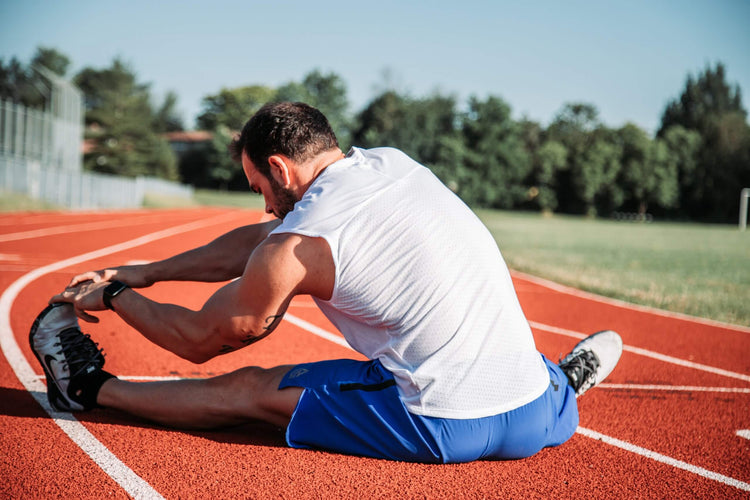
The Hidden Hamstring: Release Low Back Pain - Xero Shoes
By Matt Giordano, @theyogimatt Updated 7/26/22 The Lower Back Do you suffer from tight hamstrings?Many runners, active adventurists, and even those who sit at a desk all day experience tremendous hamstring tightness. (“Hamstring” is the term usually used for the muscle group that runs along the back of your thighs.) As a result, the pelvis might get pulled downward in a tucked (posterior tilt) position causing the low back to be chronically rounded (flexed).For most people, constantly tight hamstring muscles will result in lower back tension, discomfort or issues with your intervertebral discs – which exist between each of your vertebrae in your spine, providing cushioning for shock absorption. Preserving the natural curvature of the lower back and avoiding back pain (or nerve pain) can prove to be challenging if the hamstrings hold tension from overuse or underuse.What most people don’t understand about the body is that it is constantly trying to correct itself. When the hamstring muscles are tight and pulling the pelvis into a posterior tilt, the lower back will hold tension because those muscles, in turn, are trying to pull the pelvis back toward neutral in order to bring the proper curvature back in the lumbar spine.So most people feel the tension in the lower back and start stretching those muscles. Unfortunately, this perpetuates the issue and can even exacerbate pain. What might be the better solution is to strengthen those muscles and stretch the muscles that are the root of the tension – the hamstrings.The challenge is finding the right hamstring stretch to properly loosen the hamstrings. So what is the best approach to hamstring stretching?The “Hidden Hamstring”Something I have noticed in most athletes is that when they stretch the hamstring muscles they do all the right stretches – like a standing hamstring stretch where they bend forward over one leg, or a chair hamstring stretch where they bring their leg up on a bench, etc.However, it is rare that I would see them stretching the inner thighs as well. As a result, they are missing what is often referred to as the fourth hamstring or what I call the Hidden Hamstring: The adductor magnus.The adductor magnus squeezes the legs toward each other like the other adductors, but uniquely it also extends the thigh back behind the hip (the back leg when running or walking).Now often when we do a hamstring stretch the hamstring muscle can be tight enough that it doesn’t allow us to get into the stretch of the adductor magnus. In other words, hamstring muscle tightness holds us back from getting to the necessary depth.Rather than straining and overstretching the hamstrings to target the adductor magnus we can simply add a slightly different stretch, one that also targets the adductors (inner thighs).Let me explain how it’s done.Best Hamstring Stretches: The Magic Pose There are a couple of amazing postures in yoga that stretch the adductors and the hamstrings at the same time. One of the best ones for hamstring stretches is the “Triangle Pose.”This pose is one of the most iconic yoga postures and there’s a great reason why! It not only stretches the hamstrings, but also the inner thighs and sides of the torso. With slight variations of the shape, you can change the intensity of stretch in each area and target your tight areas, and back off your flexible ones.If you are new to the Triangle Pose or generally have tighter hamstrings and adductors I highly recommend having a yoga block, books, or a chair to put your bottom hand on so that you don’t risk straining any of the muscle groups in this posture. A slight stretch is all you need.A very similar pose is called Side Angle, and this is triangle pose but with one knee bent. With the knee bent you will reduce tension in the hamstrings and actually be able to stretch the adductor magnus a bit more easily, so I recommend starting here and then moving to Triangle Pose. If your hamstring stretches are too aggressive you risk injuring your muscles.Now for the practical part. How do you actually get into Triangle Pose and begin to loosen your tight hamstrings?How to get into Triangle Pose Start by placing your feet wide apart from each other. Turn your right foot and thigh outward until it is perpendicular to the left foot. Bend your right knee. Place your right hand on a block, book, or chair on the outside of your right thigh. (You can also place your hand and prop on the inside as well, which will change the stretch and potentially offer a more accessible experience for those with less hamstring flexibility.) You should feel a slight pulling sensation. Stay in this posture – Side Angle Pose -to target the adductor magnus for 5-8 breaths.Pro Tip: Pull your two feet toward each other to warm up the inner thighs and hamstrings. After your 5-8 breaths, your body will likely desire to straighten the front leg. If so, proceed to Triangle Pose by straightening the front leg slowly, and stopping when the stretching sensation in your hamstring is a 7 out of 10. Stay in Triangle Pose for 5-8 breaths. To come out of Triangle, re-bend the front knee, press down into your feet and rise up. Repeat this same procedure for the left side. The ResultsThe result may or may not be immediate back pain relief. Remember, hamstring tightness is only one part of the problem. (And, besides, it will take time for your tight hamstrings to improve as you add hamstring stretching to your daily routine.) You will also need to work on strengthening the muscles that extend your lumbar spine to help bring your back into its natural curve and out of the rounding position.Be sure that if you are doing “core” workouts your core routine includes just as many lower back strengtheners as front abdominal strengtheners. Your core isn’t just the front of your belly.Triangle Pose and Side Angle Pose will help you to stretch the muscles that might be tugging your tail bone down and flattening your lower back. As a result, your lower back has a chance to come back to a place of better shock absorption and away from the stacked compressive position that is so prominent in many long-distance runners.If you are used to other kinds of stretches for your tight hamstrings, like a wall hamstring stretch, try adding Side Angle and Triangle Pose hamstring stretching into your post-run/hike/climb routine while you are warm and observe the results!Until next time,Matt GiordanoMatt Giordano is an international Yoga instructor and founder of Chromatic Yoga.The content of this post does not constitute and is not intended to be a substitute for professional medical advice, diagnosis or treatment. Always seek the advice of a physician or other qualified health provider with any questions or concerns you may have about your health or a medical condition.A note from Xero ShoesI hope you enjoyed this helpful post from Matt. Correct stretching is an important part not just of avoiding hamstring tightness and finding back pain relief, but of avoiding injuries in general.I just wanted to add a note about something else that’s super important that people often overlook: form. What I mean is the way we run or even walk.Why does this matter? The way we move affects the kinds of stresses we put on our muscles, bones, ligaments, and tendons (just like how our posture can contribute to low back pain). This is true of our hamstrings along with the other muscles of our legs and feet.I mention this because people sometimes ask me, “What are the best running shoes for hamstring injury prevention or for getting over a hamstring injury?” I’m not a doctor or physical therapist, and can’t give medical advice. I can say, though, that most “typical” footwear interferes with what your body is built to do. For example, elevated heels impact posture, stiff soles and excessive support reduce foot strength, pointed toe boxes restrict natural movement, and cushioning eliminates your foot’s ability to feel the ground.If you can see that it’s probably a good thing to let your body move the way it’s made to, then you’ll want to consider a “barefoot” shoe.Our barefoot shoes are designed to do just that: allow your feet to move as they should and give your body the feedback it needs to adopt a better form. Find your pair of Xero Shoes here.You can read more about form, why it matters, and even how it relates to lower back pain here.I always want to make sure I’m clear about this: if you have a running injury, talk to a medical professional. They may recommend physical therapy or other kinds of treatment. I’m not a doctor and nothing I am saying here is intended to be medical advice or to take the place of professional guidance.
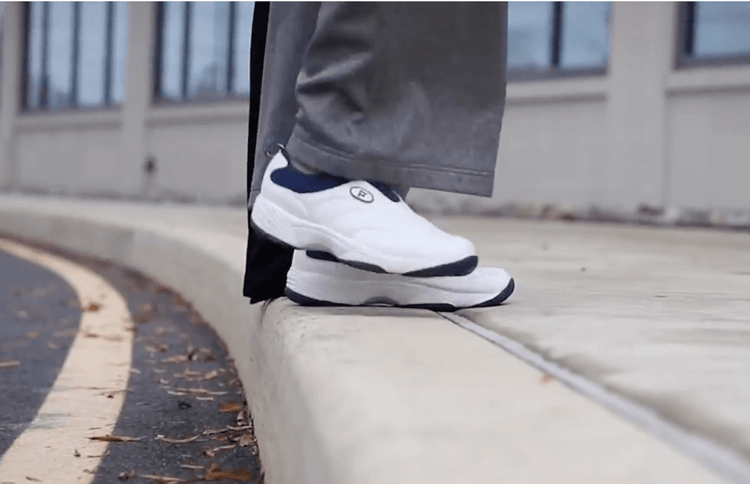
More Buzz about Vibrating (and Parkinsons)
It's happening again, I think.In the Thomas Industry, David Mantey reports on a new device designed to help Parkinson's patients "walk with greater ease."What does it do?It applies vibration your feet.A few years ago, I reported on a similar device.So...Q: What is vibration doing?A: Stimulating your nervous system, feet first.Q: Why might you need extra stimulation?A: Because you aren't letting your feet do one their primary jobs: FEELING (there's a reason you have so many nerve endings in the soles of your feet) Take a look at this screen grab from the video about the "VibeForward" device:That's over an inch of padding between you and the ground. And a sole that's stiff enough to prevent your foot from moving naturally.This is like putting your foot in a cast.Now here's the fun question:Q: What else could stimulate the nerves in your feet?A: USING THEM.Taking off your shoes so you don't have an an inch of padding between you and the ground. And then, for extra credit, walk on surfaces that, well, stimulate your feet -- grass, sidewalks, trails, gravel, river rocks... you get the idea.At the very least, put LESS between you and the ground (that's how we design Xero Shoes -- to give you feedback and ground-feel, but still have some protection).Is this exactly the same as the VibeForward? No, walking barefoot doesn't require batteries, or an app, or use "artificial intelligence."Q: Will kicking off your kicks and using your feet naturally have the same effect for Parkinson's patients who suffer from freezing gait?I don't know. But, then again, the data isn't in about the VibeForward yet either.The Michael J. Fox Foundation gave the University of Delaware $440,000 to study the VibeForward.Here's my big question:Q: How can we get the Michael J. Fox Foundation to fund a study on natural movement -- something that's available to everyone NOW?Got an answer?The content of this post does not constitute and is not intended to be a substitute for professional medical advice, diagnosis or treatment. Always seek the advice of a physician or other qualified health provider with any questions or concerns you may have about your health or a medical condition.
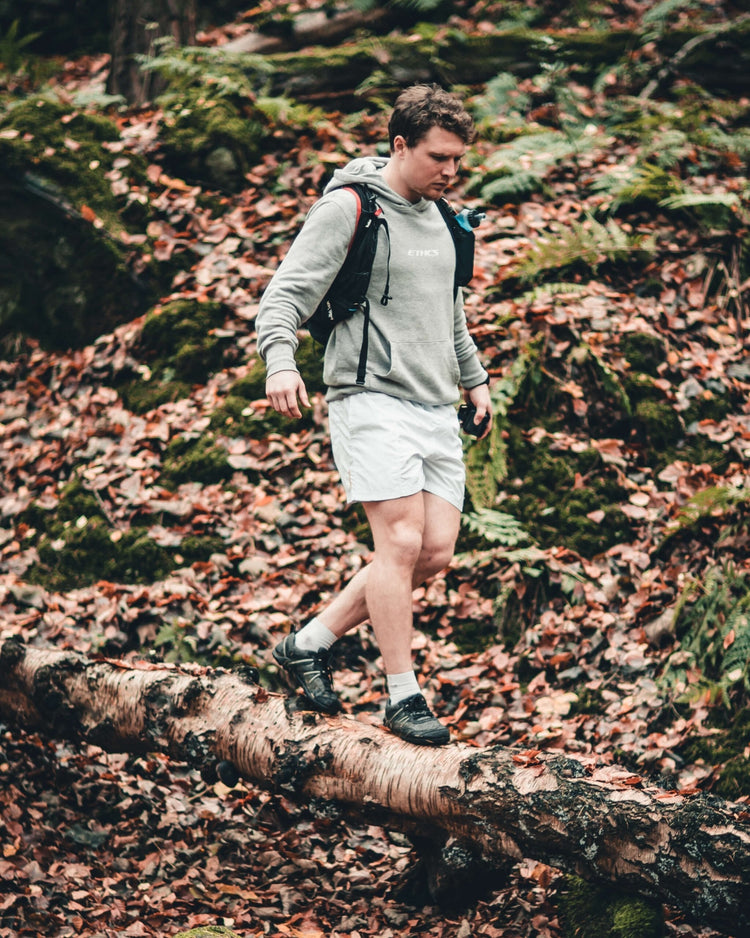
Hiking for Health
Want to improve your health AND have fun? Take a hike! Hiking has significant health benefits. Here are just 5: Hiking on rugged trail surfaces is a natural way to engage your core muscles, Burn calories -- Hiking on uneven terrain increases the amount of energy used by your body by 28 percent compared to walking on flat ground, Get strong -- Hiking helps to strengthen often neglected muscles in your hips, knees, ankles, and feet to improve balance and stability, Hiking is good for your brain: research shows that time spent in natural environments engages all five senses and calms brain activity, Instant meditation -- just being out in mother nature reduces your mind’s tendency to get stuck on negative, self-focused thought patterns – resulting in a happier, healthier you! So, go on a hike! Your body and mind will thank you.Your new favorite shoes for hiking and trail running:The content of this post does not constitute and is not intended to be a substitute for professional medical advice, diagnosis or treatment. Always seek the advice of a physician or other qualified health provider with any questions or concerns you may have about your health or a medical condition.
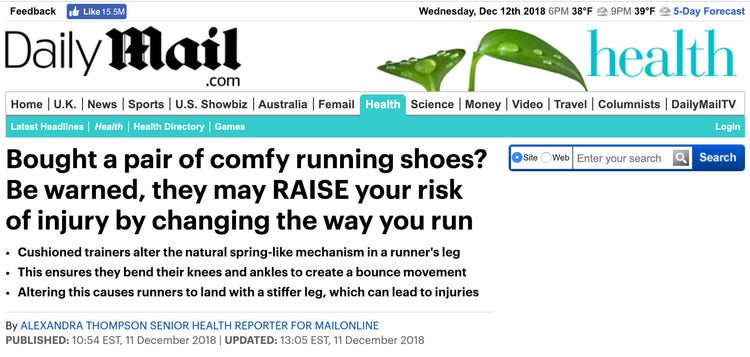
Comfy, Cushioned Shoes Can CAUSE Injuries
This just in from the "Tell me something I didn't know" department. ;-)The UK's Daily Mail reports, "Comfy trainers RAISE the risk of injury." You would think that a major publication telling readers why "maximalist shoes" are bad for you would make me happy, but read on and you'll see why my glee is tempered with frustration. (Click on the image, above, to see the article or find it on the Daily Mail site: https://www.dailymail.co.uk/health/article-6483593/Comfy-trainers-RAISE-risk-injury.html) In short the article comments on research from Dr. Juha-Pekka Kulmala, and says: [Between] 37 and 56 per cent of joggers experience injuries every year worldwide. These injuries are thought to largely occur due to the vertical force that is created when a runner's foot hits the ground. To reduce this, many trainer manufacturers have added cushioning to their shoes' soles, however, there is no evidence that this actually prevents injuries. ...Runners' feet hit the ground harder when they were wearing cushioned trainers. A video analysis showed the runners bent their knees and ankles less when they wore the cushioned shoes, which caused their bodies to slow down quicker and placed extra stress on their legs. Now, this shouldn't be news to people familiar with Xero Shoes, or this site, or the myriad studies done showing the problems with cushioned footwear and the benefits of truly minimalist shoes (not shoes sold with "minimalist" in the name, but without the same design principles.So, on the one hand, I'm thrilled to see the truth in print.On the other hand, this article does the same thing that others of this type have done, namely: Makes it seem like the bad control "the Brooks Ghost 6" is good for you, since it's better than the Hoka Conquest. Paints the picture that there's actually a debate, or a value for what we affectionately call "foot coffins" (any shoe that doesn't let your foot bend, flex, move, feel). In the article, Dr. Kade Paterson, a podiatrist at the University of Melbourne, says: 'As a sports podiatrist, I’ve seen patients who’ve reported improvements with maximalist running shoes and others who’ve got injured in them so there probably isn’t a one-size-fits-all approach.' Dr. Paterson added the results do not suggest runners should ditch cushioned shoes entirely and said 'like many health-related things, we should be somewhere in the middle'. The only way you can come to that conclusion is if you do something else that most articles of this type do:Don't reference the research on true minimalist footwear, like that done by Dr. Irene Davis or Sarah Ridge or Isabel Sacco and others. This research paints a compelling picture for why natural movement, well, is better than shoving your foot into something that's not foot-shaped, not flexible, has elevated heels with flared soles, and too much padding. You know, like the Brooks Ghost 6.Even more absurd is the warning given at the end of the article:Dr. Kulmala has previously warned about the trend of barefoot running, which he only recommends if you land at the front of your feet. Most people land on their heels, which creates a larger force and therefore needs more cushioning, he added.ARGH!Talk about missing the point. Or putting the cart before the horse. Or confusing cause and effect. Or some better metaphor or analogy than I can think of now.Harvard's Dr. Daniel Lieberman and others have shown that putting padding under your heel is what encourages heel striking to begin with, and that running barefoot tends to naturally shift you to a forefoot landing, which reduces those stressful forces on your bones and joints because you use your muscles, ligaments and tendons as the natural springs and shock absorbers they're meant to be.So, put it all together...Look, I'm glad that the "myth of maximalism" is being dismantled, but I hope that the "truth of natural movement" gets more attention in the process.The content of this post does not constitute and is not intended to be a substitute for professional medical advice, diagnosis or treatment. Always seek the advice of a physician or other qualified health provider with any questions or concerns you may have about your health or a medical condition.
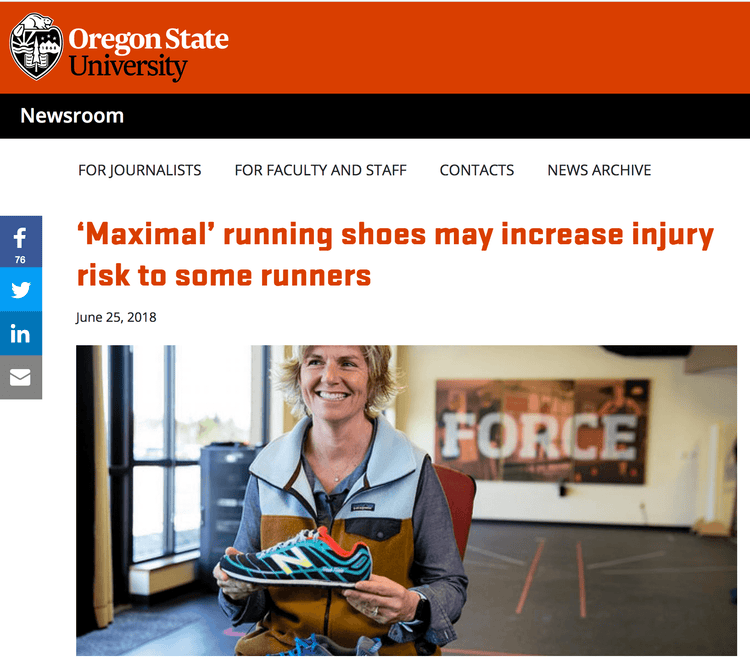
Maximal Shoes Not a Solution?
From the "We told you so" file comes this new bit of running shoe research:The study concluded that runners experienced a higher impact peak and increased loading rate with the “maximal” shoes. Increases in both factors are associated with a greater likelihood of injury, such as plantar fasciitis and tibial stress fractures.Actually, this isn't "new." Harvard's Dr. Irene Davis discovered the same thing.In short: cushioning doesn't cushion.Why not?Think about your foot -- 1/4 of the bones and joints in your entire body are in your feet and ankles. And you have more nerve endings in your soles than anywhere but your fingertips and lips.Given all that, it seems pretty clear that your feet are made to bend, move, flex, and FEEL the world.That means your brain is designed to KNOW what's going on down there... so it can help you control your whole body, head to toe, more effectively and efficiently.If you attenuate the information your brain wants to receive (probably NEEDS to receive) with a bunch of cushioning, one adaptation is to land harder so that it can feel something.If you want to reduce impact forces, what you ultimately need is some form of shock absorber that can adjust almost instantly to changing loads, changing speed, and changing angles. Ideally, something that doesn't break down and need replacing every 3-500 miles. And even better if it can return energy -- or generate additional energy.Oh, wait, you already have that!It's called the muscles, ligaments, and tendons in your feet, ankles, legs, knees, and back.And if you use them naturally, they can keep you happy well into your old age.That's what Xero Shoes are all about. Letting your body do what's natural with just enough protection -- and some style -- for your active life.The content of this post does not constitute and is not intended to be a substitute for professional medical advice, diagnosis or treatment. Always seek the advice of a physician or other qualified health provider with any questions or concerns you may have about your health or a medical condition.


